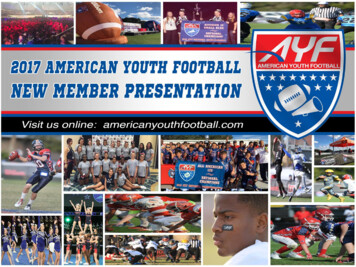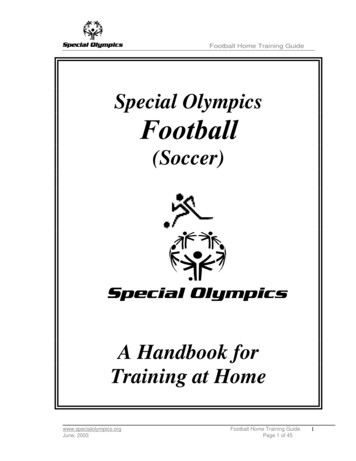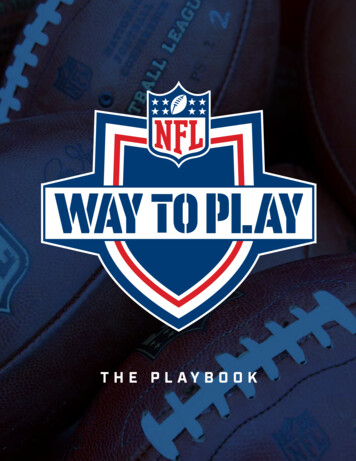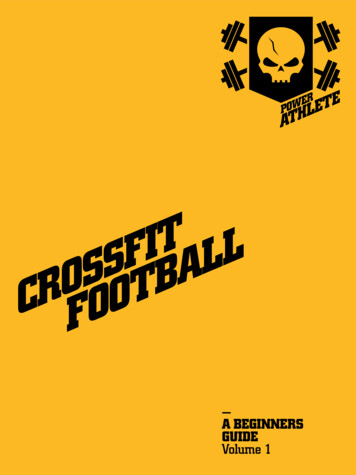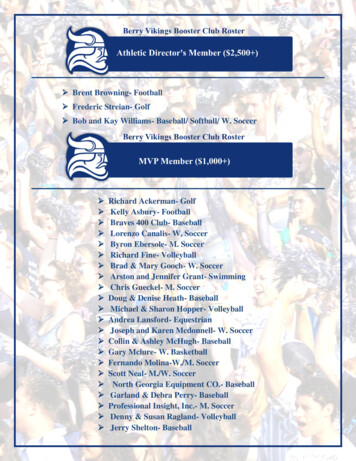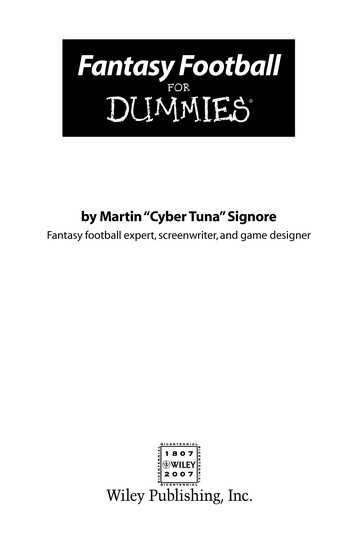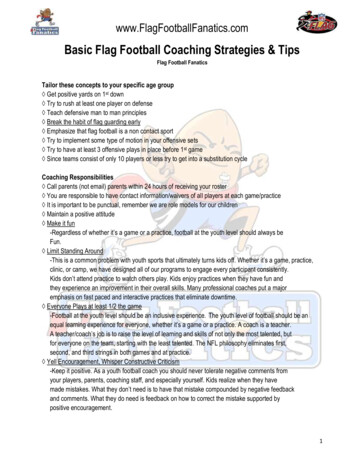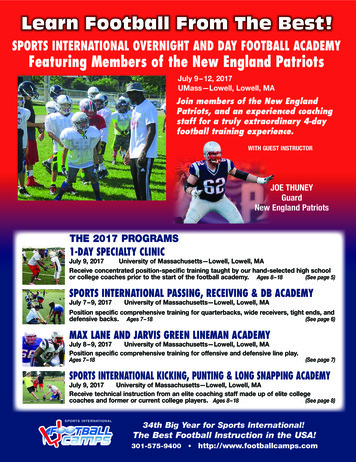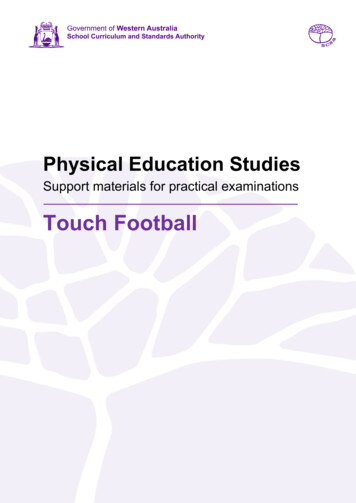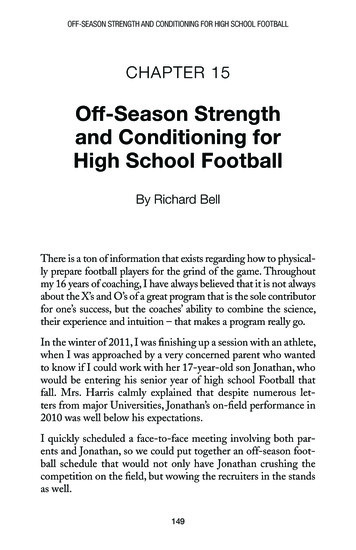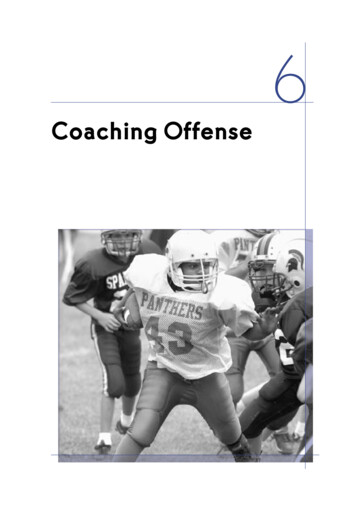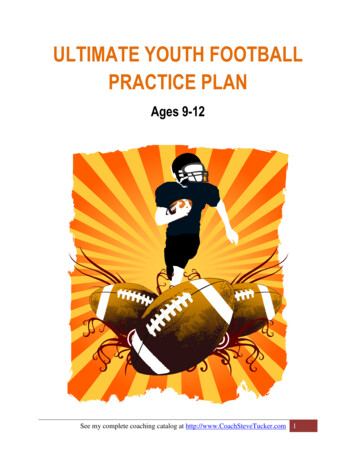
Transcription
ULTIMATE YOUTH FOOTBALLPRACTICE PLANAges 9-12See my complete coaching catalog at http://www.CoachSteveTucker.com 1
Copyright NoticeThe material enclosed is copyrighted. You do not have resell rights or giveaway rights to the material providedherein. Only customers that have purchased this material are authorized to view it. If you think you may have anillegally distributed copy of this material, please contact us immediately. Please emailsupport@knowledgespotinc.com to report any illegal distribution.Copyright 2009 CoachSteveTucker.com & FootballTutorials.com All rights reserved.No part of this publication may be reproduced or transmitted in any form or by any means, electronic or mechanical,including photocopying or by information storage and retrieval systems. It is illegal to copy this material and publishit on another web site, news group, forum, etc. even if you include the copyright notice.Legal NoticesWhile all attempts have been made to verify information provided in this publication, neither the author nor thepublisher assumes any responsibility for errors, omissions or contrary interpretation of the subject matter herein. Thepublisher wants to stress that the information contained herein may be subject to varying state and/or local laws orregulations. All users are advised to retain competent counsel to determine what state and/or local laws orregulations may apply to the user's particular operation. The purchaser or reader of this publication assumesresponsibility for the use of these materials and information. Adherence to all applicable laws and regulations,federal, state and local, governing professional licensing, operation practices, and all other aspects of operation inthe US or any other jurisdiction is the sole responsibility of the purchaser or reader. The publisher and authorassume no responsibility or liability whatsoever on the behalf of any purchaser or reader of these materials. Anyperceived slights of specific people or organizations is unintentional.Consult Your PhysicianThe techniques, ideas, and suggestions in this document are not intended as a substitute for proper medical advice!Consult your physician or health care professional before performing any exercise or exercise technique. Anyapplication of the techniques, ideas, and suggestions in this document is at the reader's sole discretion and risk.The author and publisher of this document and their employers make no warranty of any kind in regard to thecontent of this document, including, but not limited to, any implied warranties of merchantability, or fitness for anyparticular purpose. The author and publisher of this document and their employers are not liable or responsible toany person or entity for any errors contained in this document, or for any special, incidental, or consequentialdamage caused or alleged to be caused directly or indirectly by the information contained in this document.See my complete coaching catalog at http://www.CoachSteveTucker.com 2
ContentsPurpose of the Practice. 4Equipment Needed . 4Warm-Up (10 Minutes). 5Carioca Drill. 5Quick Feet . 6Individual Skills (20 Minutes) . 7Fumble Drill . 7Pepper Receiving Drill . 8Group Skills (20 Minutes) . 9Chute Drill (Tackling Chute) . 9Shuffle Drill . 10Special Teams (10 Minutes) . 11Staying Onside . 11Return Kick Drill . 12Offensive Period (25 Minutes). 13Gauntlet Drill . 135 Man Seat Roll . 14Defensive Period (25 Minutes) . 15Fit Position . 15Pursuit Drill. 16Cool Down and Conditioning (10 Minutes) . 17Back and Forth . 17Cool Down the Field . 18Ages 9-12 Football Practice Template . 19See my complete coaching catalog at http://www.CoachSteveTucker.com 3
Purpose of the PracticeAt this age players are starting to understand the overall game of football better. Therefore, youcan begin to make each drill a little more involved. You can also begin to build on some of thebasic skills that were taught to players at a younger age. However, the players are still veryyoung. So you want to continue to stress the basics so that all players become fundamentallystrong. You also want to continue to make the game fun for the players. However, now you canbegin introduce a little more discipline into the practice too.At this age the players will come in all shapes and sizes. Therefore, you want to make sureplayers are paired up well for each drill. You don’t want a small quick player drilling with alarge slower player. You want to group according to size, age, and ability as much as possible.With the players still developing, you don’t want to lock any player into 1 role. You want tocontinue to teach all the players all the necessary skills so that they will be solid all-aroundfootball players as they get older.For example, you don’t want to label a larger kid a lineman and not teach him any of the skillslike catching and running with the ball. That kid may very well end-up slimming down andgrowing into a different body type. He may end-up being one of the faster kids and want to playrunning back or wide receiver when he’s in high school.So, make sure you give all players the opportunity to learn how to do everything well.The following drills will help players develop into great all around football players.Equipment NeededFor these drills all players need to be in full pads. You will also need blocking pads, cones, andblocking sleds.Obviously you need footballs too.See my complete coaching catalog at http://www.CoachSteveTucker.com 4
Warm-Up (10 Minutes)Players should always stretch first. Coaches should lead the players through their stretching sothat no injuries occur because of a lack of stretching. After proper stretching you should warmup the players for the rest of practice. During the warm-ups you should also help make the kidsbetter football players. These first 2 drills will do just that.Carioca DrillPurpose: This drill is meant to help players with their footwork. It will also help players withtheir overall agility.How it’s Run: Players will form 6 lines and face the coach. The coach will be 20 yardsdownfield. The first player in each line will turn to the side. Their shoulders should be parallel tothe sideline. On the whistle the players will carioca 20 yards downfield (to they are even with thecoach) and then 20 yards back to their starting spot. They will then go to the end of the line andthe next player will step up and wait for the whistle.Players should always keep their upper body parallel with the sideline. Their hips should rotateas they run sideways placing left foot over right and then left foot behind right. Each playershould go through the line at least twice.Result: Coaches should make sure all players are keeping their upper bodies parallel whilerotating their hips. Coaches should also make sure all players are using the proper footwork.Getting the footwork down is much more important than the speed at which the drill is done.See my complete coaching catalog at http://www.CoachSteveTucker.com 5
Quick FeetPurpose: This drill is another drill to help players with their footwork. It will also help playerswith their overall agility.How it’s Run: Players will form 6 lines and face the coach. The coach will be 10-20 yardsdownfield. The first player in each line will take a couple steps toward the coach. They shouldcontinue to face the coach.On the whistle the players will get low and take quick choppy steps. They will move to the rightand then back to the left. All the while they will keep their eyes on the coach and keep theirshoulders square to the coach.When the coach gives the signal the players should sprint forward 20 yards. Then they shouldjog back to the end of the line and wait to perform the drill again.Each player should go through the line at least three times.Result: Coaches should make sure all players are keeping their upper bodies parallel with thecoach. The players should all stay low too. Their feet should be moving quickly and they shouldsprint forward the full 20 yards when the coach gives the signal.See my complete coaching catalog at http://www.CoachSteveTucker.com 6
Individual Skills (20 Minutes)At this age, the individual part of the practice should focus on teaching the players how to do thelittle things well. It can work on any skill that a player has to possess to be good at any position.The following 2 drills focus on different skills that all players should possess.Fumble DrillPurpose: This is a great drill to help players become more aggressive. It also helps players learnto go after a fumble with reckless abandon.How it’s Run: For this drill 2 players will try to recover a loose football. You will need 2 linesof players. You may want to pair up players of similar size and age.The 2 lines should be about 8 yards apart. The coach will have footballs and stand between the 2lines of players. The first player in each line will step up and wait for the coach to throw the ballout. The coach can either throw the ball or roll the ball out in front of the players. The coachshould try to get the ball out away from the players and an equal distance from each player.Both players will charge after the ball and try to recover it.The coach can elect to make theplayer who doesn’t recover the ball run a lap or do a similar activity.Result: Coaches should look to make sure both players are aggressively going after the ball.See my complete coaching catalog at http://www.CoachSteveTucker.com 7
Pepper Receiving DrillPurpose: This is a great drill to help players learn to catch the ball while staying focused on theball. Once the players have the basics of how to catch down, this drill can be run. It shouldcertainly be run with any player who might catch the ball during the game but it can be run withall the players.How it’s Run: Divide players into groups of 6. 5 players will stand in a line and 1 player willface the line about 6-8 yards away. There will be 2 footballs. The player facing the line will have1 football and the player on the end of the line will have the other football. The player facing theline will be the receiver.The receiver will start the drill by throwing his ball to the second player in line. As soon as theball is thrown, the player at the end of the line will throw his football to the receiver. Thereceiver will catch the football and throw it to the next player in line. Then he’ll receive the nextpass from the line and so on.Result: Coaches should make sure that the receiver is catching the ball using the propertechnique. Also, the drill should run smoothly and there shouldn’t be any lapses when there isn’ta football in the air.See my complete coaching catalog at http://www.CoachSteveTucker.com 8
Group Skills (20 Minutes)For the group skills you can work on anything that all the players need to work on together. Youcan focus on defense or offense. The drills just need to involve most or all of the players.Chute Drill (Tackling Chute)Purpose: This drill will help players with their tackling. It will also help players become moreaggressive. This drill will teach players not to shy away from contact.How it’s Run: For this drill you will need two lines of players about 6 yards apart. The playerswill be facing each other. The 2 lines of players will form the chute for the drill. 2 players at atime will step into the chute at opposite ends. 1 player will have a ball. He will be the ball carrier.The other player will be the tackler. The players should be similar in size.On the coach’s whistle the 2 players will run at each other. The ball carrier will try to run overthe tackler (he shouldn’t try to avoid him) and the tackler will try to tackle the ball carrier. Soboth players should run at each other full speed. The 2 players should crash together in the chute.Either the ball carrier will remain standing and keep running or the ball carrier will be tackled. Ifthe ball carrier remains standing then he wins, if not then the tackler wins.Result: Coaches should make sure that both players are aggressive. Also, both players should getas low as possible just before contact.See my complete coaching catalog at http://www.CoachSteveTucker.com 9
Shuffle DrillPurpose: This drill will help players with their footwork. The drill is especially useful forlinebackers and running backs but can be used for all players.How it’s Run: Place 7 cones within a length of 10 yards. You can set up 1 line of cones on onehash mark and another line of cones on the other hash mark. Then you can have 2 lines going atthe same time.Players will line-up at the first cone. The first player in line will shuffle past the first cone withquick choppy steps. Then he’ll run forward in between the 2 cones, his feet should still be quickand choppy. Then he’ll run back out from between the 2 cones and shuffle past the next cone.Then he’ll run in between the next 2 cones, go backward, and move on past the next cone.This will be repeated until the player gets to the last cone. Then he’ll turn and spring up field.Each player should perform the drill at least twice.Result: Coaches need to focus on the player’s feet. The players should constantly be using quickchoppy steps. They should also stay low to the ground and their upper bodies should stay squarewith the cones at all times.See my complete coaching catalog at http://www.CoachSteveTucker.com 10
Special Teams (10 Minutes)At this age, how much special teams are used is really up to the coach. However, as the playersget older they need to begin to understand how special teams are played. They especially need tolearn how to cover a kick and return a kick. These 2 drills will help with that.Staying OnsidePurpose: This is a great drill to practice staying onsides during a kickoff. It will also help withconditioning.How it’s Run: A ball is placed at the goal line, then the 15 yard line, and then every 15 yards thelength of the field. The kickoff team will line-up to kick the first ball. The kicker will signal thatthe kickoff will occur and then run up and kick the ball. All the players will sprint forward as ifthey are covering a kick.Each player will run about 10 yards downfield and then prepare for another kickoff. This timethe ball will be kicked from the 15 yard line and then from the 30 yard line and so on.The drill will continue all the way down the field. At each spot the kicker can actually kick theball of can just feign that he’s kicking the ball.Result: Coaches should look to make sure that all players are staying onside each time the ball iskicked. Also, every player should be sprinting forward just as they would for an actual kickoff ina game.See my complete coaching catalog at http://www.CoachSteveTucker.com 11
Return Kick DrillPurpose: It’s important for players to set-up in the correct spot to block when returning a kick.This is a great drill to teach the return team how to properly block for the return. This drillpractices getting in position for the return.How it’s Run: The kick return team will be on the field for this drill. They will set-up howeverthey are asked to set-up in an actual game. There will be a coach standing near where theopposing kicker would kickoff. This coach will simulate each kickoff. There will be anothercoach about 30 yards downfield. This coach will throw the ball to one of the return men. Thethrowing of the ball will simulate the actual kick.The coach will throw the ball to a return man. The return team has to find the ball then sprint tothe correct spot on the field where they will have to block for the return.Result: Coaches need to make sure that all players know where they’re supposed to go to blockwhile the ball is in the air. All players need to get to the correct spot as fast as possible.See my complete coaching catalog at http://www.CoachSteveTucker.com 12
Offensive Period (25 Minutes)At this level the offensive period will usually divide the “skilled” players from the offensivelineman. So, here is a drill for the “skilled” players and a drill for the offensive linemen.Gauntlet DrillPurpose: This drill can be run with a pass or with a simple run. It’s often best to use a pass sothat all the skill players get a chance to catch the ball and run with it. The main purpose of thedrill is to teach the players to concentrate on catching the ball, securing it, and then running withit. This drill will also help the quarterback with his timing.How it’s Run: Players will line-up on the outside of the field. The quarterback will be in themiddle of the field with a football. There will be 3 blocking dummies or players holding pads.Two blocking dummies will be about 5 yards downfield. They will be together with a space of 2or 3 yards between them. They will be slightly inside of the line of players (closer to the middleof the field). The other blocking dummy will be about 5 yards farther downfield.The first player in line will run a quick a quick slant, catch the ball, run between the blockingdummies, make a move on the last blocking dummy, and continue up field.The quarterback will snap the ball, take a quick drop, and deliver the ball on the quick slant.Result: Coaches should look to make sure the players are catching and securing the ballproperly. They should also make sure the quarterback is dropping back properly and deliveringthe ball on time.See my complete coaching catalog at http://www.CoachSteveTucker.com 13
5 Man Seat RollPurpose: This drill will teach the offensive linemen agility and how to explode into their blocks.How it’s Run: You will need a 5 man blocking sled or five single blocking sleds all side by side.You will need 5 offensive linemen.The drill will move from left to right. The right tackle will begin at the first sled. He will get intoa 3-point stance. On the whistle he will explode into the sled, recover with a seat roll, and thenline-up in a 3 point stance next to the 2nd sled. While the OT does a seat roll, the next lineman(the right guard) will get into a 3-point stance across from the first sled. On the whistle they’llboth explode into their sleds, recover with a seat roll, and more onto the next sled. The centerwill then join the drill and so on.The drill continues until all 5 linemen go through every sled. Then the drill can move from left toright.Result: Coaches need to make sure players are using the proper technique. Players need toexplode and then recover immediately.See my complete coaching catalog at http://www.CoachSteveTucker.com 14
Defensive Period (25 Minutes)As with the offense, it’s important to divide the players for the defensive period. However, thereare some drills you can do with all the players. Tackling is a skill that all the defenders need toknow. Both of these drills focus on tackling.Fit PositionPurpose: This drill will help players learn the proper tackling position. This position issometimes called the “fit position.”How it’s Run: Players will pair off and face each other on a chosen line of scrimmage. Oneplayer will be the defender while the other will be the ball carrier.On the coach’s signal the defenders will walk up into the fit position. They will grab the otherplayer (the ball carrier) as if to tackle them and then hold that position. The coach will analyzeeach fit position and correct the position if necessary. Then the players will switch roles and thecoach will analyze the other players’ fit positions.Result: Coaches should make sure the tackler has the proper base. The butt should be stickingout and the back should be straight. The head should be up, eyes should be open, and the front ofthe shoulder or chest should be making the contact.See my complete coaching catalog at http://www.CoachSteveTucker.com 15
Pursuit DrillPurpose: This drill will help players learn the proper angle of pursuit on the ball carrier. It willalso help the defense learn to react to a play. Finally, the ball carriers in the drill can also drillreceiving a pitch and running with the ball down the sideline.How it’s Run: This drill will use a full defense (all 11 players), 2 potential ball carriers, and acoach with a few footballs. A cone will be set on each side of the field between the hash marksand the sideline at the line of scrimmage. The 2 potential ball carriers will line-up on each hashmark about 3 yards behind the line of scrimmage. The coach will line-up on the line ofscrimmage with a football. The defense will align in the called formation and will play the calleddefense.The coach will simulate the snap and either drop back to throw the ball or pitch the ball to one ofthe ball carriers. If the coach drops back to pass then the defense should drop back into theirzones. The coach will throw the ball deep and high. The defense should try to intercept the ball atits highest point and then return the ball. The other defenders should form a blocking wall for thereturn.The coach could also pivot and pitch the ball to one of the ball carriers. The ball carrier will takethe pitch, place the ball in his outside arm, and run around the cone to the sideline. The defenseshould not react until the ball carrier has the ball. Then they should pursue using the properangles.Result: Coaches should make sure all the defenders are reacting properly and playing the properangles. Also, the coach should make sure the ball carrier is receiving the pitch with his hands andtucking the ball away properly.See my complete coaching catalog at http://www.CoachSteveTucker.com 16
Cool Down and Conditioning (10 Minutes)This part of the practice needs to work on the conditioning of players and allow the players tocool down. The first drill will help condition the players and the last drill will help the playerscool down.Back and ForthPurpose: This is a great conditioning drill. It can be run as many times as the coach wants. Thedrill also helps with agility.How it’s Run: Players will line-up in one of five lines. The coach will stand 20 yards downfield.When the coach blows the whistle the players will sprint toward the coach. When the coachblows the whistle again the players will back peddle in the opposite direction. On the nextwhistle the players will sprint forward again. The next whistle will force the players to backpeddle again and so on.The drill continues this way until all players are able to run past the coach.Result: Coaches should look to make sure all players are giving maximum effort. Also, playersshould use the right form when running. Players should also be planting their dominant foot andexploding forward or backward.See my complete coaching catalog at http://www.CoachSteveTucker.com 17
Cool Down the FieldPurpose: This is a great cool down drill that also helps players work on their footwork.How it’s Run: Players form 5 lines at one end of the field. The first player in each line will jogto the 10 yard line. Once at the 10 the players will walk to the 20 yard line. Then they’ll turn, runbackward to the 30 yard line, and then walk again. Once they reach the 40 yard line they will jogto the 50 yard line.This will repeat until the players reach the opposite goal line. The players will jog 10 yards, walk10 yards, run backward for 10 yards, walk for 10 yards, jog for 10 yards, and so on.Once the first group of players reaches the 10 yard line, the next group should go.Players should make sure they pump their arms as the jog and run backward. Also, they shouldexplode off their dominant foot when beginning to job and when beginning to run backward.Result: Coaches should look to make sure all players are running with the proper form. Allplayers should also run the drill properly.See my complete coaching catalog at http://www.CoachSteveTucker.com 18
Ages 9-12 Football Practice TemplateChoose one or two drills to complete for each practice segmentDate Team CoachTimePractice Segment10 Mins.Warm-UpCarioca DrillWarm-UpQuick FeetIndividual SkillsFumble DrillIndividual SkillsPepper Receiving DrillGroup WorkChute Drill (Tackling Chute)Group WorkShuffle DrillSpecial TeamsStaying OnsideSpecial TeamsReturn Kick DrillOffensive PeriodGauntlet DrillOffensive Period5 Man Seat RollDefensive PeriodFit PositionDefensive PeriodPursuit DrillCool Down / ConditioningBack and ForthCool Down / ConditioningCool Down the Field20 Mins.20 Mins.10 Mins.25 Mins.25 Mins.10 Mins.DrillCommentsSee my complete coaching catalog at http://www.CoachSteveTucker.com 19
ball is thrown, the player at the end of the line will throw his football to the receiver. The receiver will catch the football and throw it to the next player in line. Then he’ll receive the next pass from the line and so on. Result: Coaches should make sure that the
